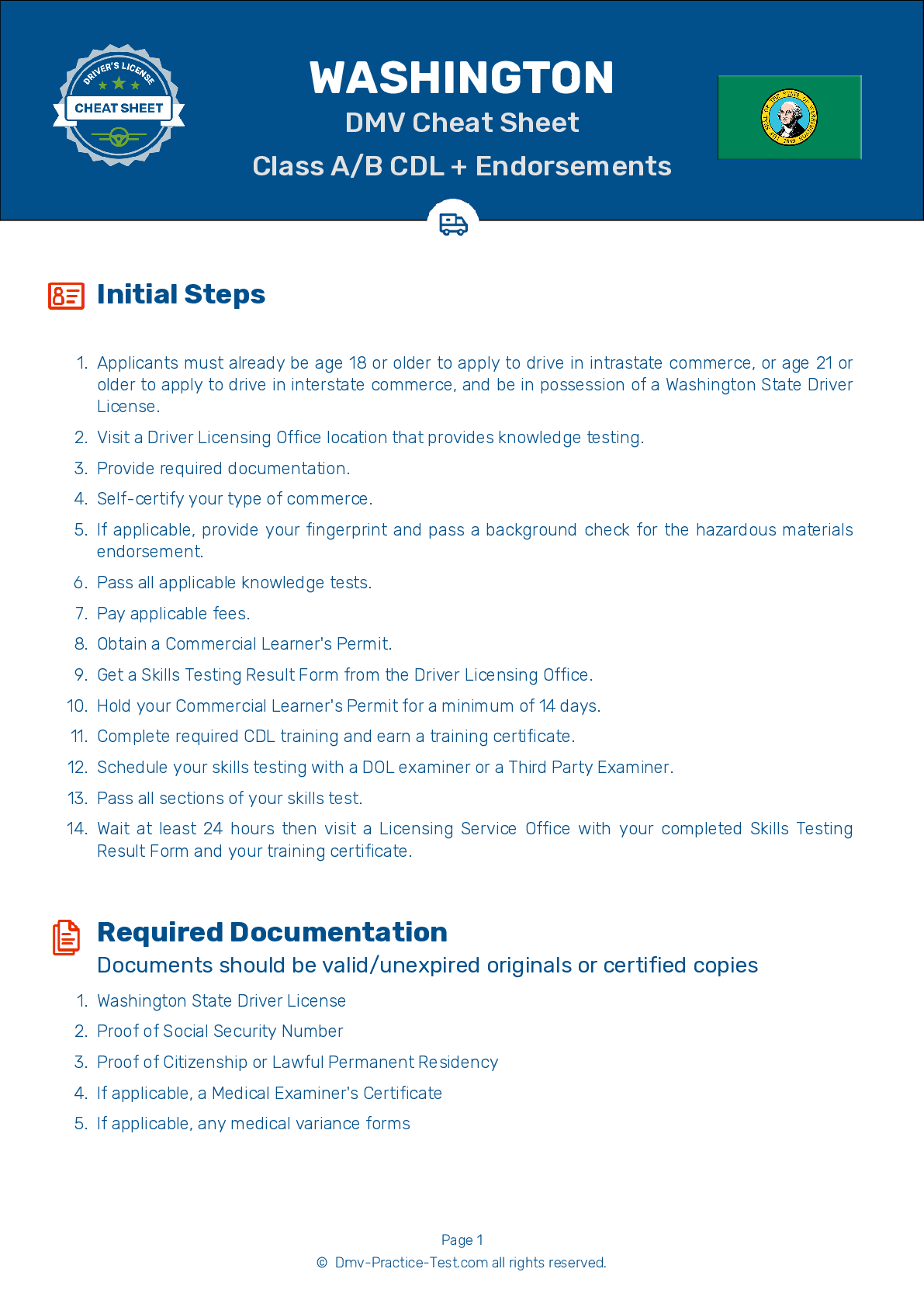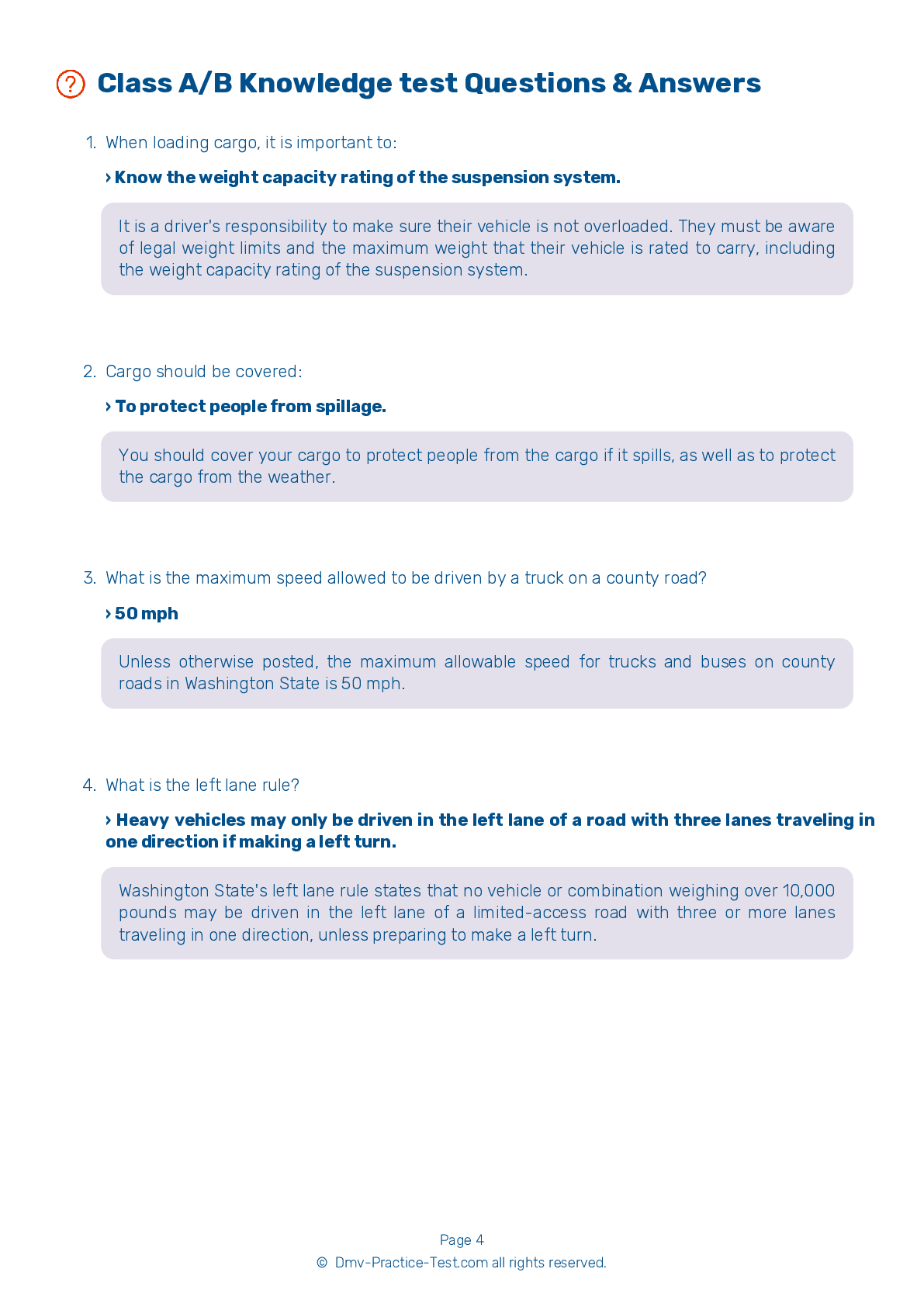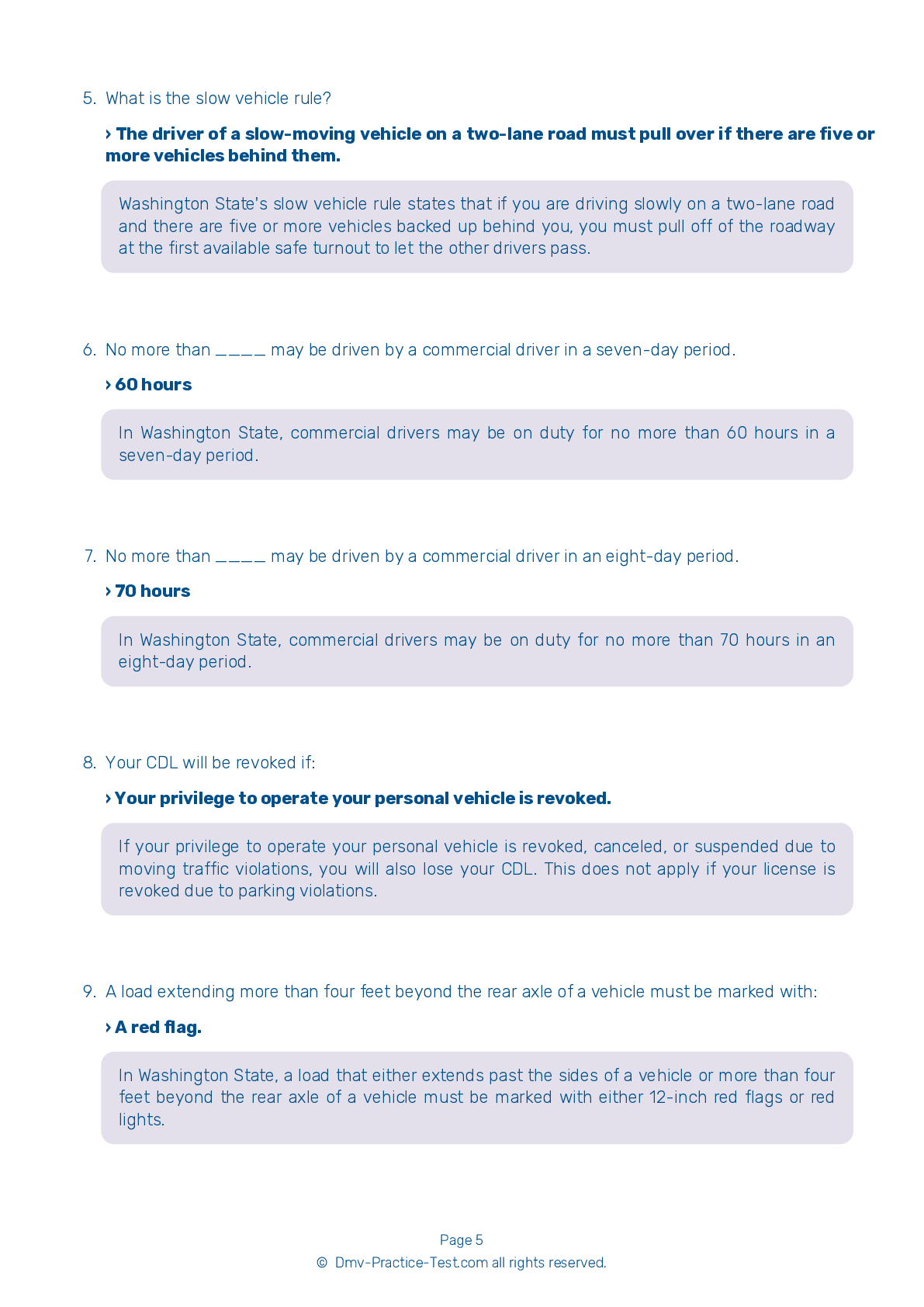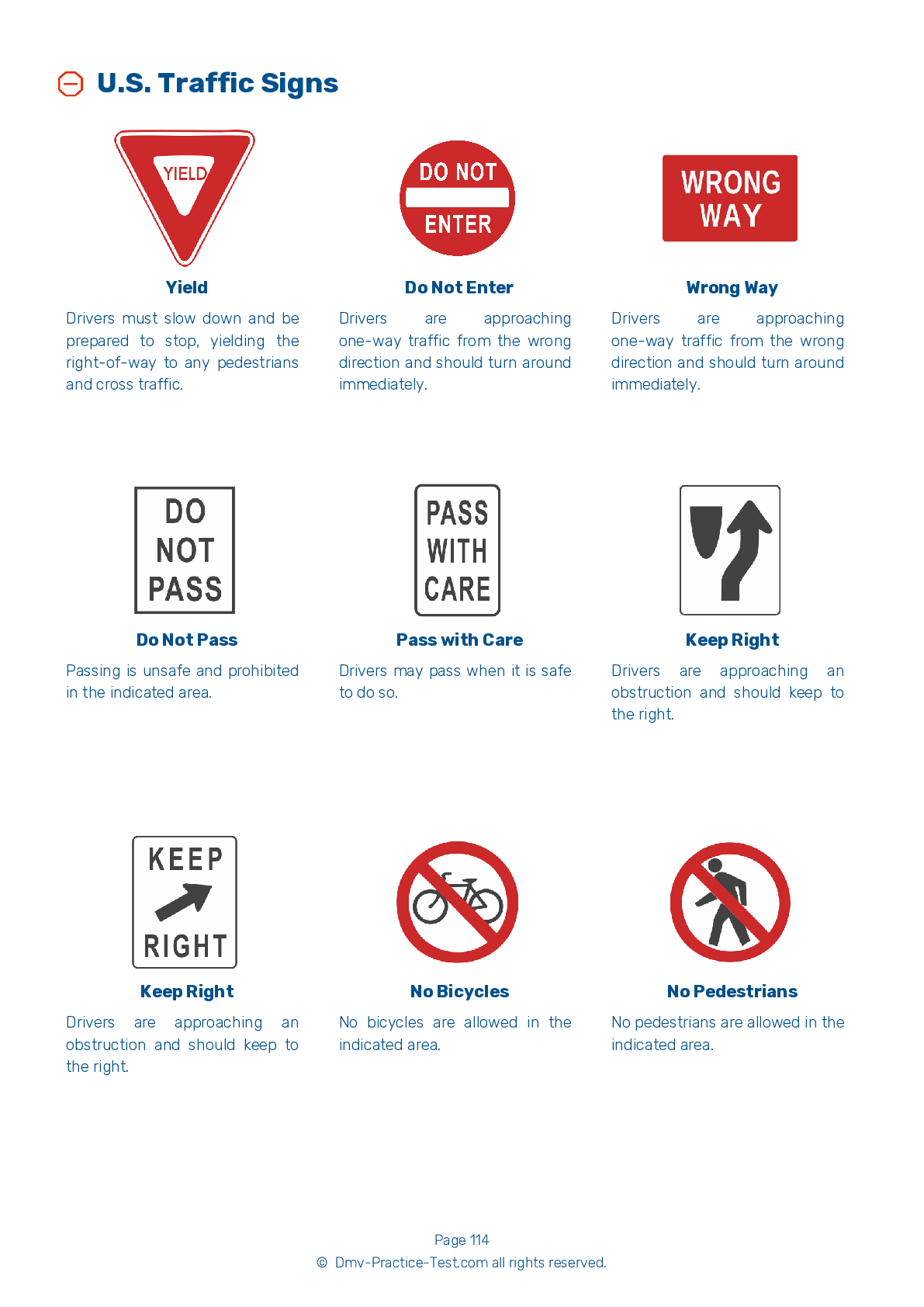Knowledge Test Class B #1
Class B Driving Test | Washington 2025 #1 Page 7 of 7
Train for FREE online with our Washington class B license test. The official exam test consists of several obligatory parts, with all of them checking your knowledge of different blocks of road rules. If you need to obtain a WA CDL class B permit in 2025, practice as much as possible. Free sample tests published on our website will help you check and improve your knowledge and boost your grades. Please bear in mind that CDL class B requirements may vary from state to state.
50
40
20
43 . On a slippery road, a driver should:
Under slippery conditions, you should drive slowly and smoothly. Make turns as gently as possible and do not pass other vehicles unless you have to.
44 . A low air pressure warning signal should activate:
In an air brake system, a low air pressure warning signal must come on if air pressure in the tanks falls below 60 psi. This warning signal may come in the form of a light, a buzzer, or a wig wag.
45 . If an aggressive driver is involved in a crash down the road, you should:
If you observe a crash involving an aggressive driver, you should stop a safe distance from the crash scene, wait for police to arrive, and inform them of the aggressive behavior you witnessed.
46 . What is the maximum legal weight to be placed on a single axle?
The allowable gross weight of a bus or truck depends on its tire size, the number of axles, and the spacing of axles (or axle groups). In Washington State, the weight of a commercial vehicle is limited to no more than 20,000 pounds on any single axle.
47 . Do not base your decision to shift gears on:
One way to know when it is time to shift gears is to learn your vehicle's operating rpm range. You should shift up when your engine reaches the top of that range. You can also learn which speeds each gear is good for and shift up based on your speedometer.
48 . If a vehicle's Anti-Lock Braking System (ABS) is malfunctioning:
An Anti-Lock Braking System (ABS) intervenes to reduce brake pressure if there is a risk of wheel lockup. If the ABS isn't working, the vehicle's basic braking functions are not affected. A driver should continue to drive and brake in a normal manner.
49 . In a vehicle with dual parking control valves, a separate air tank can be used:
In a vehicle with dual parking control valves, there is a separate air tank that can be used to temporarily release the spring brakes if they have been activated due to low air pressure. Pushing in the proper control will release the spring brakes for a short period of time, allowing the driver to move the vehicle in an emergency.
50 . Blocking is used to:
Blocking may be used on all sides of a piece of cargo to keep it from sliding while the vehicle is in motion.
2025 Washington | Frequently Asked Questions
To acquire a CDL Hazmat endorsement in Washington, you must have a valid CDL. Next, pass the Hazardous Materials Endorsement Knowledge Test at a Washington State driver licensing office. Then, undergo a federal background check and fingerprinting at an approved location. Finally, after receiving clearance, visit a driver licensing office to add the endorsement to your CDL.
To obtain a CDL Hazmat license, you must first have a valid Commercial Driver's License (CDL). You also need to pass the Hazardous Materials Endorsement Knowledge Test. A federal background check and fingerprinting are also required. Additionally, you must be at least 21 years old and a U.S. citizen or have legal status in the U.S.
When applying for a CDL Hazmat endorsement, you'll need your current Commercial Driver's License (CDL), proof of U.S. citizenship or lawful permanent residency (like a birth certificate or green card), and a completed Medical Examination Report Form. Also, you'll need proof of your Social Security number and a completed Hazardous Materials Endorsement application.
Yes, there is a dedicated written test for the CDL Hazmat endorsement. This is known as the Hazardous Materials Endorsement Knowledge Test. It covers topics like loading and unloading hazardous materials, bulk packaging marking, driving and parking rules, and emergency response procedures. You must pass this test to get the Hazmat endorsement.
The Hazardous Materials Endorsement Knowledge Test for the CDL Hazmat endorsement covers a range of subjects including identification of hazardous materials, proper loading and unloading procedures, safety procedures in transport, emergency response procedures, and understanding of the Hazardous Materials Regulations. It also tests knowledge of placarding and marking requirements.
Yes, there are extra charges associated with obtaining a CDL Hazmat endorsement. These include fees for the written test, fingerprinting, and a background check. The exact costs can vary by state and the specific services used for fingerprinting and background checks. It's best to check with your local DMV for the most accurate information.
Yes, obtaining a CDL Hazmat endorsement does require a background check and security clearance. The Transportation Security Administration (TSA) conducts these checks to ensure that the applicant does not pose a security threat. The process includes fingerprinting, a review of criminal history, and immigration status check for non-U.S. citizens.
Yes, specialized training is mandatory for the CDL Hazmat endorsement. Applicants must pass the Hazardous Materials Endorsement Knowledge Test. Additionally, they must undergo a TSA background check. While not a formal "certification," these steps are necessary to ensure the driver understands how to safely handle hazardous materials.
No, you cannot legally transport hazardous materials without a valid Commercial Driver's License (CDL) with a Hazardous Materials (Hazmat) endorsement. This endorsement ensures that drivers have the necessary training and knowledge to handle hazardous materials safely and in compliance with the law. Violating this can result in hefty fines and penalties.
You can add the CDL Hazmat endorsement to your current CDL license. It doesn't require a new application for a CDL license. However, you will need to fill out a separate application for the endorsement, pass the Hazmat knowledge test, and complete a TSA background check before the endorsement is added to your existing CDL.



